1997 HONDA ODYSSEY seats
[x] Cancel search: seatsPage 5 of 241
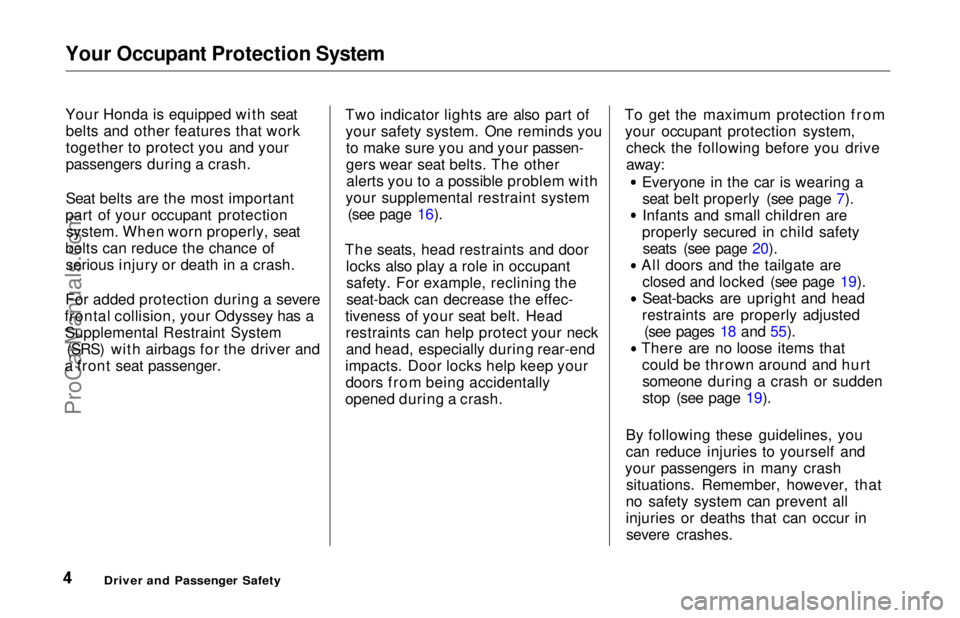
Your Occupant Protection System
Your Honda is equipped with seat
belts and other features that work
together to protect you and your
passengers during a crash.
Seat belts are the most important
part of your occupant protection system. When worn properly, seat
belts can reduce the chance of serious injury or death in a crash.
For added protection during a severe
frontal collision, your Odyssey has a Supplemental Restraint System (SRS) with airbags for the driver and
a front seat passenger. Two indicator lights are also part of
your safety system. One reminds youto make sure you and your passen-
gers wear seat belts. The otheralerts you to a possible problem with
your supplemental restraint system (see page 16).
The seats, head restraints and door locks also play a role in occupantsafety. For example, reclining the
seat-back can decrease the effec-
tiveness of your seat belt. Head restraints can help protect your neckand head, especially during rear-end
impacts. Door locks help keep your doors from being accidentally
opened during a crash. To get the maximum protection from
your occupant protection system, check the following before you drive
away:
Everyone in the car is wearing a
seat belt properly (see page 7). Infants and small children are
properly secured in child safety seats (see page 20). All doors and the tailgate are
closed and locked (see page 19). Seat-backs are upright and head
restraints are properly adjusted (see pages 18 and 55). There are no loose items that
could be thrown around and hurtsomeone during a crash or sudden
stop (see page 19).
By following these guidelines, you
can reduce injuries to yourself and
your passengers in many crash situations. Remember, however, that
no safety system can prevent all
injuries or deaths that can occur in severe crashes.
Driver and Passenger SafetyProCarManuals.comMain Menu Table of Contents s t
Page 6 of 241
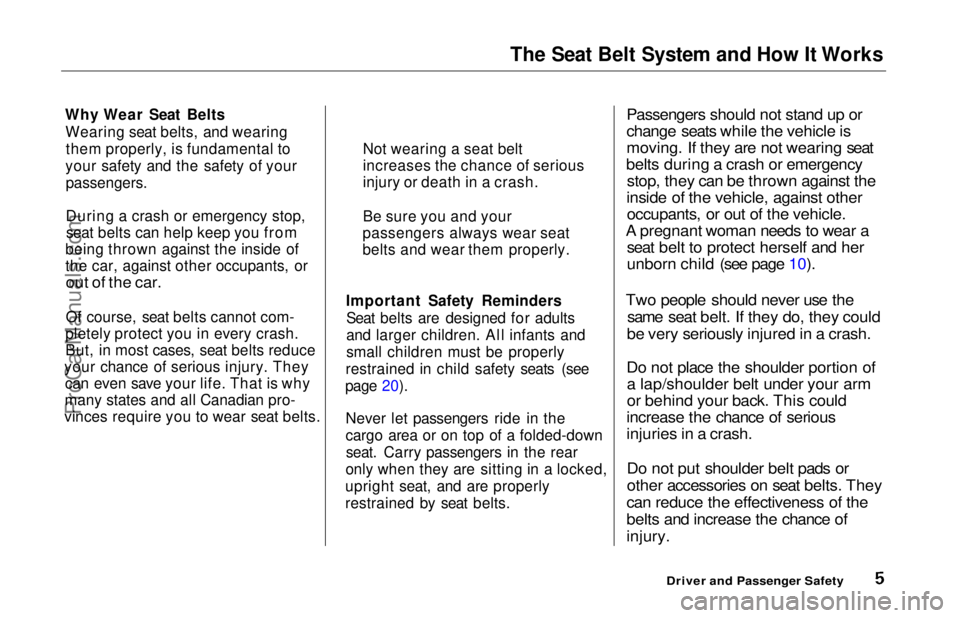
The Seat Belt System and How It Works
Why Wear Seat Belts Wearing seat belts, and wearingthem properly, is fundamental to
your safety and the safety of your
passengers.
During a crash or emergency stop,seat belts can help keep you from
being thrown against the inside of
the car, against other occupants, or
out of the car.
Of course, seat belts cannot com-
pletely protect you in every crash.
But, in most cases, seat belts reduce
your chance of serious injury. They can even save your life. That is why
many states and all Canadian pro-
vinces require you to wear seat belts. Important Safety Reminders
Seat belts are designed for adults
and larger children. All infants and
small children must be properly
restrained in child safety seats (see
page 20).
Never let passengers ride in the
cargo area or on top of a folded-downseat. Carry passengers in the rear
only when they are sitting in a locked,
upright seat, and are properly
restrained by seat belts.
Passengers should not stand up or
change seats while the vehicle is
moving. If they are not wearing seat
belts during a crash or emergency stop, they can be thrown against the
inside of the vehicle, against other occupants, or out of the vehicle.
A pregnant woman needs to wear a seat belt to protect herself and her
unborn child (see page 10).
Two people should never use the same seat belt. If they do, they could
be very seriously injured in a crash.
Do not place the shoulder portion of a lap/shoulder belt under your arm
or behind your back. This could
increase the chance of serious
injuries in a crash.
Do not put shoulder belt pads or
other accessories on seat belts. They
can reduce the effectiveness of the
belts and increase the chance of
injury.
Driver and Passenger Safety
Not wearing a seat belt
increases the chance of serious
injury or death in a crash.
Be sure you and your
passengers always wear seat
belts and wear them properly.ProCarManuals.comMain Menu Table of Contents s t
Page 10 of 241
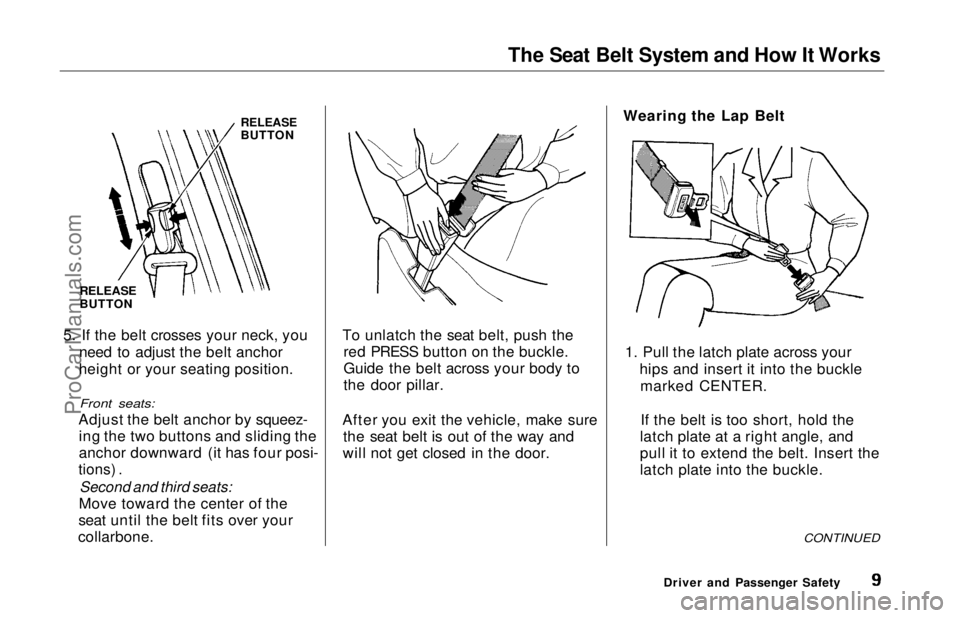
The Seat Belt System and How It Works
RELEASE
BUTTON
RELEASE
BUTTON
5. If the belt crosses your neck, you need to adjust the belt anchor
height or your seating position.
Front seats:
Adjust the belt anchor by squeez- ing the two buttons and sliding the
anchor downward (it has four posi-
tions) .
Second and third seats:
Move toward the center of the
seat until the belt fits over your
collarbone.
To unlatch the seat belt, push the
red PRESS button on the buckle.
Guide the belt across your body to
the door pillar.
After you exit the vehicle, make sure the seat belt is out of the way and
will not get closed in the door. Wearing the Lap Belt
1. Pull the latch plate across your hips and insert it into the bucklemarked CENTER.
If the belt is too short, hold the
latch plate at a right angle, and
pull it to extend the belt. Insert the
latch plate into the buckle.
CONTINUED
Driver and Passenger SafetyProCarManuals.comMain Menu Table of Contents s t
Page 23 of 241
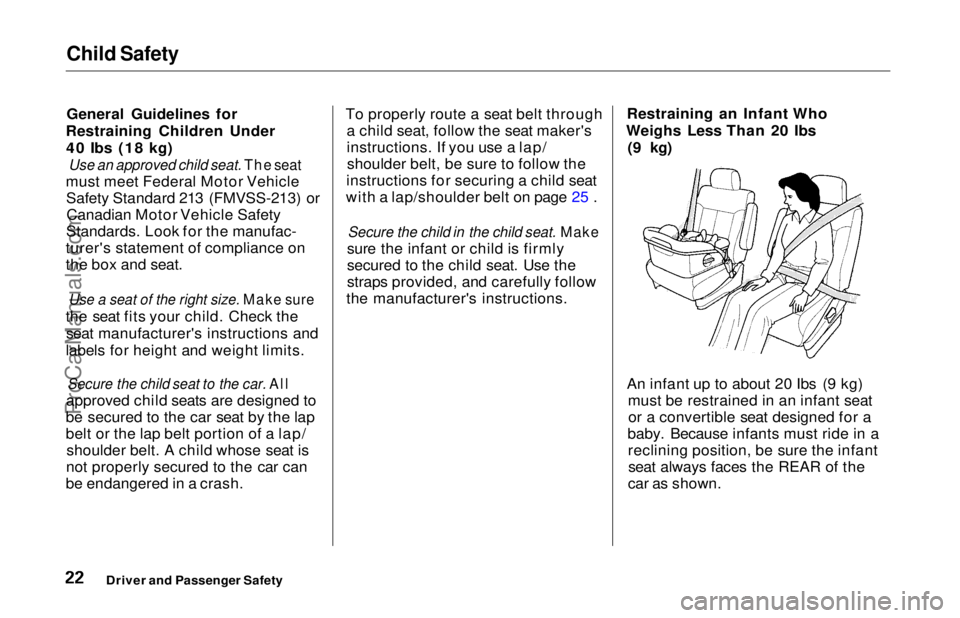
Child Safety
General Guidelines for
Restraining Children Under 40 Ibs (18 kg)
Use an approved child seat. The seat
must meet Federal Motor Vehicle Safety Standard 213 (FMVSS-213) orCanadian Motor Vehicle Safety
Standards. Look for the manufac-
turer's statement of compliance on
the box and seat.
Use a seat of the right size. Make sure
the seat fits your child. Check the seat manufacturer's instructions and
labels for height and weight limits.
Secure the child seat to the car. All
approved child seats are designed to
be secured to the car seat by the lap
belt or the lap belt portion of a lap/ shoulder belt. A child whose seat is
not properly secured to the car can
be endangered in a crash. To properly route a seat belt through
a child seat, follow the seat maker's
instructions. If you use a lap/shoulder belt, be sure to follow the
instructions for securing a child seat
with a lap/shoulder belt on page 25 .
Secure the child in the child seat. Make
sure the infant or child is firmly
secured to the child seat. Use the
straps provided, and carefully follow
the manufacturer's instructions. Restraining an Infant Who
Weighs Less Than 20 Ibs (9 kg)
An infant up to about 20 Ibs (9 kg) must be restrained in an infant seator a convertible seat designed for a
baby. Because infants must ride in a reclining position, be sure the infantseat always faces the REAR of the
car as shown.
Driver and Passenger SafetyProCarManuals.comMain Menu Table of Contents s t
Page 24 of 241
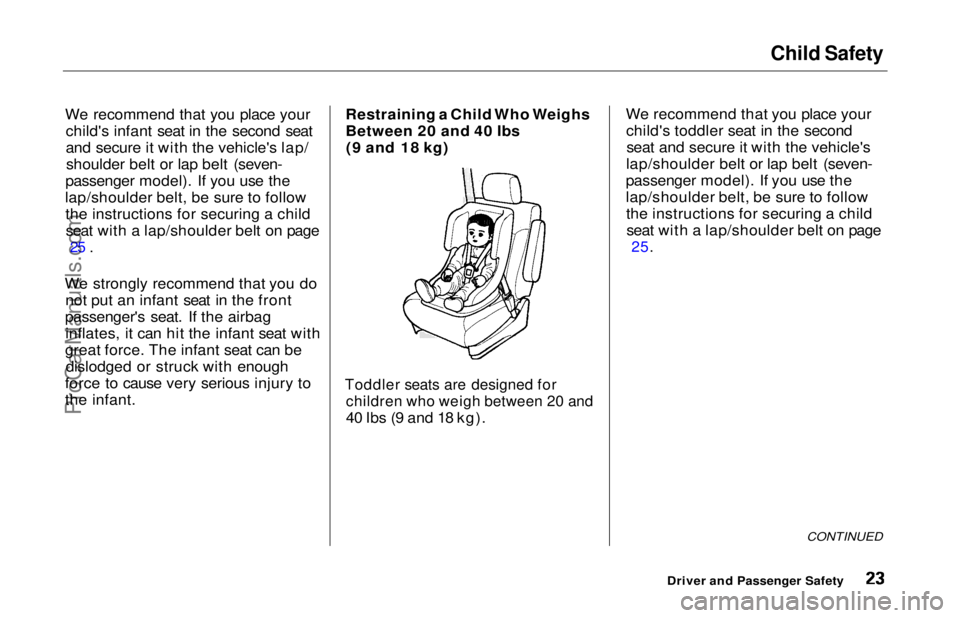
Child Safety
We recommend that you place your child's infant seat in the second seat
and secure it with the vehicle's lap/shoulder belt or lap belt (seven-
passenger model). If you use the
lap/shoulder belt, be sure to follow the instructions for securing a childseat with a lap/shoulder belt on page
25 .
We strongly recommend that you do not put an infant seat in the front
passenger's seat. If the airbag inflates, it can hit the infant seat with
great force. The infant seat can be dislodged or struck with enough
force to cause very serious injury to
the infant. Restraining a Child Who Weighs
Between 20 and 40 Ibs
(9 and 18 kg)
Toddler seats are designed for
children who weigh between 20 and
40 Ibs (9 and 18 kg). We recommend that you place your
child's toddler seat in the secondseat and secure it with the vehicle's
lap/shoulder belt or lap belt (seven-
passenger model). If you use the
lap/shoulder belt, be sure to follow the instructions for securing a childseat with a lap/shoulder belt on page
25.
CONTINUED
Driver and Passenger SafetyProCarManuals.comMain Menu Table of Contents s t
Page 25 of 241
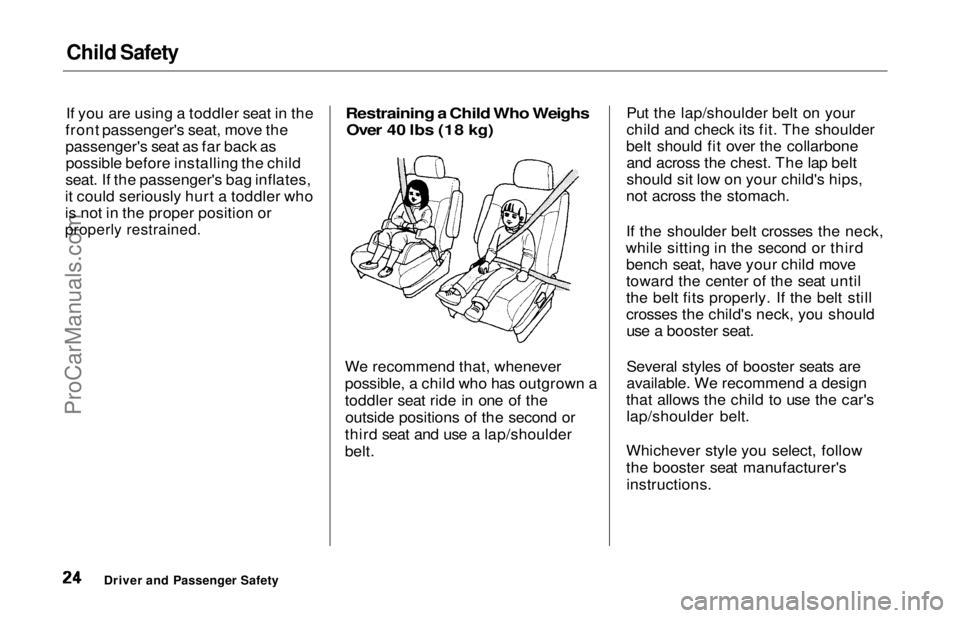
Child Safety
If you are using a toddler seat in the
front passenger's seat, move the
passenger's seat as far back as possible before installing the child
seat. If the passenger's bag inflates,
it could seriously hurt a toddler who
is not in the proper position or
properly restrained.
Restraining a Child Who Weighs
Over 40 lbs (18 kg)
We recommend that, whenever
possible, a child who has outgrown a
toddler seat ride in one of the outside positions of the second or
third seat and use a lap/shoulder
belt. Put the lap/shoulder belt on your
child and check its fit. The shoulder
belt should fit over the collarbone and across the chest. The lap belt
should sit low on your child's hips,
not across the stomach.
If the shoulder belt crosses the neck,
while sitting in the second or third bench seat, have your child move
toward the center of the seat until
the belt fits properly. If the belt still
crosses the child's neck, you shoulduse a booster seat.
Several styles of booster seats are
available. We recommend a design
that allows the child to use the car's lap/shoulder belt.
Whichever style you select, follow
the booster seat manufacturer's instructions.
Driver and Passenger SafetyProCarManuals.comMain Menu Table of Contents s t
Page 32 of 241
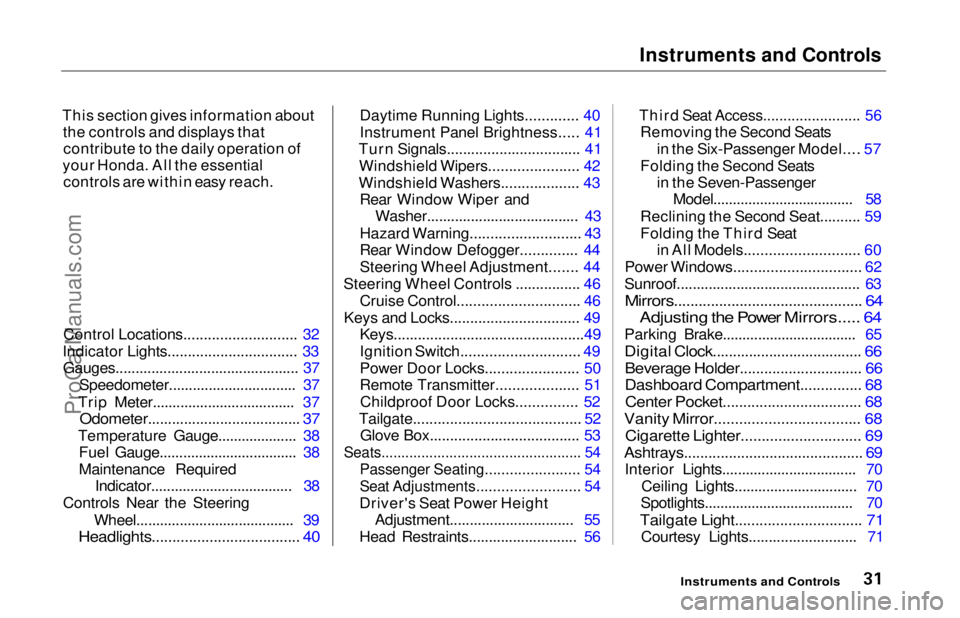
Instruments and Controls
This section gives information about the controls and displays thatcontribute to the daily operation of
your Honda. All the essential controls are within easy reach.
Control Locations............................ 32
Indicator Lights................................ 33 Gauges.............................................. 37
Speedometer................................ 37
Trip Meter.................................... 37
Odometer...................................... 37
Temperature Gauge.................... 38 Fuel Gauge................................... 38
Maintenance Required Indicator.................................... 38
Controls Near the Steering
Wheel........................................ 39
Headlights.................................... 40
Daytime Running Lights............. 40
Instrument Panel Brightness..... 41
Turn Signals................................. 41
Windshield Wipers...................... 42
Windshield Washers................... 43 Rear Window Wiper and Washer......................................
43
Hazard Warning...........................
43
Rear Window Defogger.............. 44
Steering Wheel Adjustment....... 44
Steering Wheel Controls ................ 46 Cruise Control.............................. 46
Keys and Locks................................ 49
Keys...............................................49
Ignition Switch............................. 49
Power Door Locks....................... 50
Remote Transmitter....................
51
Childproof Door
Locks............... 52
Tailgate......................................... 52 Glove Box..................................... 53
Seats.................................................. 54
Passenger Seating....................... 54
Seat Adjustments......................... 54
Driver's Seat Power Height Adjustment............................... 55
Head Restraints........................... 56
Third Seat Access........................ 56
Removing the Second Seats
in the Six-Passenger Model.... 57
Folding the Second Seats in the Seven-PassengerModel.................................... 58
Reclining the Second Seat.......... 59
Folding the Third Seat in All Models............................ 60
Power Windows............................... 62
Sunroof.............................................. 63
Mirrors.............................................. 64
Adjusting the Power Mirrors..... 64
Parking Brake.................................. 65
Digital Clock..................................... 66
Beverage Holder.............................. 66
Dashboard Compartment............... 68
Center Pocket.................................. 68
Vanity Mirror................................... 68
Cigarette Lighter............................. 69
Ashtrays............................................ 69
Interior Lights.................................. 70
Ceiling Lights............................... 70
Spotlights...................................... 70
Tailgate Light............................... 71
Courtesy Lights........................... 71
Instruments and ControlsProCarManuals.comMain Menu s t
Page 55 of 241
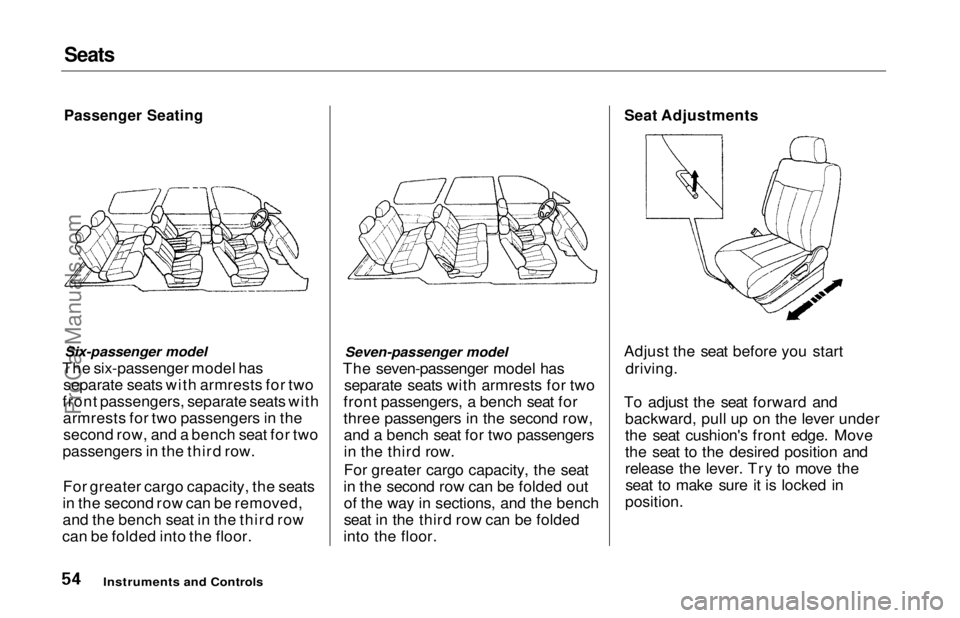
Seats
Passenger Seating
Six-passenger model
The six-passenger model has separate seats with armrests for two
front passengers, separate seats with armrests for two passengers in thesecond row, and a bench seat for two
passengers in the third row.
For greater cargo capacity, the seats
in the second row can be removed,
and the bench seat in the third row
can be folded into the floor. Seven-passenger model
The seven-passenger model has separate seats with armrests for two
front passengers, a bench seat for
three passengers in the second row, and a bench seat for two passengers
in the third row.
For greater cargo capacity, the seat
in the second row can be folded out of the way in sections, and the bench
seat in the third row can be folded
into the floor.
Seat Adjustments
Adjust the seat before you start driving.
To adjust the seat forward and backward, pull up on the lever under
the seat cushion's front edge. Move
the seat to the desired position and
release the lever. Try to move theseat to make sure it is locked in
position.
Instruments and ControlsProCarManuals.comMain Menu Table of Contents s t